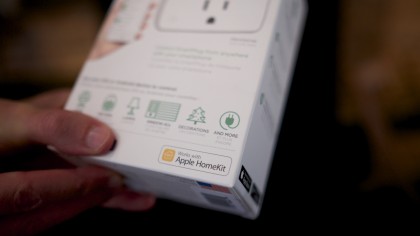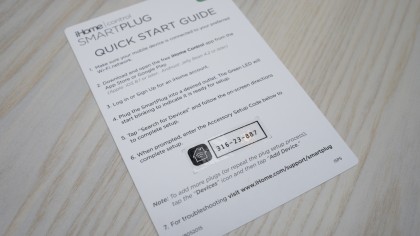Apple HomeKit is doing for the connected home what the App Store did for the smartphone
Applying the App Store's rigorous certification process to smart home devices

In terms of revolutionary technologies happening right now, none is as ambitious as the connected home.
It promises to save us time, energy (both electrical and personal) and, if the promises of connected smoke alarm manufacturers are to be believed, it also has the potential to save lives.
But for all the talk of how connected all these devices are going to be, so far they haven't been that good at, well, connecting.
Of course they can connect to the internet and by extension to your phone, but so far as connectivity between these smart devices goes, "piecemeal" is probably the best word to describe it. The ultimate aim of the smart home is to have all these devices acting in unison, but up until now they've been working as isolated actors.

The future of the connected home doesn't mean taking out your phone to turn on your lights using a dedicated smart-lighting app. It means having a sensor by your front door that automatically tells your lights, your thermostat, and your ceiling fan that you're home and responds appropriately.
HomeKit is Apple's attempt to make the promises of the smart home a reality, and to do it the company appears to be making use of the same philosophy that made its App Store a force to be reckoned with back in 2008 – namely, a stringent approval process and an ever-growing ecosphere of devices.
But, in order to fully understand how it hopes to achieve this, we're going to need to explore what it was that made the App Store such a significant step forward when it first launched.
Sign up for breaking news, reviews, opinion, top tech deals, and more.
A history of the App Store
Apple wasn't the first company to allow third-party software to be developed for its phones, but its App Store completely changed how the process worked.
Previous devices such as Microsoft's Pocket PCs and the Palm Pilot allowed third-party software to be installed on them, but the process was completely decentralised.
Developers had to host their software themselves, and then had to deal with customer payments themselves.
But the problem was even worse for consumers, who had to navigate to third-party sites of questionable quality, enter their credit card details, and then download software which had been quality checked by the developers themselves.
When the App Store came along, it was a massive improvement for developers who had a central location to upload all their software to, but it was completely revolutionary for customers, who for once could download mobile software that they could be sure would meet certain minimum standards due to Apple's own certification process.

Apple's control over its ecosystem means that for the first time third-party mobile software became mainstream. Users who would have never previously installed software on their phones previously loaded their iPhones up with apps.
The App Store was not just a big deal for Apple, but it also meant that mobile software in general has supplanted desktop software in importance. The future of technology is all in the app, and its a revolution that started with Apple's App Store, and the philosophy it brought into this new area.
But what does this all have to do with HomeKit?
Turning the App Store philosophy to HomeKit
When you download any piece of software from the App Store you know it's going to work – almost without exception – and Apple wants to bring that same philosophy to HomeKit.
Instead of a location on Apple's virtual storefront, though, you can tell a product has been officially certified by Apple by the small 'Works with Apple HomeKit' logo which can be found on the box of the device.

What this logo means is that the device has been fully tested by Apple and is compatible with Apple's new 'Home' app – which allows you to control all of your HomeKit devices from a single app – and HomeKit APIs in order to offer a fully consistent experience.
It will support Apple's secure protocol, which means that your smart connected front-door lock is protected against cyber-attacks, but this end-to-end encryption means that not even Apple can gather information about you from your smart home devices.
From a usability point of view, a HomeKit-compatible device will also fully support Apple's APIs, and will be fully interoperable with other HomeKit devices.
It also means that you can connect any products into the Home app by scanning a small card in the box to quickly and easily integrate it into the app alongside the rest of your HomeKit accessories.
You can then control it directly from the app, regardless of the manufacturer's own software.

One interconnected ecosystem
One could easily argue that the App Store was so successful because developers only needed to be approved once to make it on any number of Apple devices. Soon, Apple's certification process and APIs mean that HomeKit enabled devices will form a single unified ecosystem across the entire Home app.
What this means is that so long as a smartbulb is HomeKit-enabled it should be controllable like any other smartbulb. It's a consistent experience, both for developers and manufacturers as well as the people like you and I who want one simplified, interconnected experience.
No longer will one poorly designed and completely isolated app ruin your experience.
Similarly, Apple's design guidelines on the App Store means that Apple can prevent apps that don't meet these same standards from making it onto their store. It's a mark of quality that should mean that takes the risk out of buying something new because you know that it will meet a minimum standard set by Apple.
Taking the automated home mainstream
Early adopters are prepared to put up with flakey interfaces and devices that you need to creatively coax into working with one another.
But Apple has never been one to target these early adopters – there were smartwatches long before the Apple Watch, for example. It wants to catch the mainstream users, those who are willing to spend money on a product only once they have the assurance that it will work the way it should do right out of the box.

When it came to the App Store, Apple achieved this through its rigorous certification process that meant that people knew what they could expect from any piece of software.
Now, with HomeKit, Apple is working its certification magic once more to ensure that users can buy home automation devices secure in the knowledge that they'll work as intended both behind the scenes and on the stage.
Whether this is enough bring the mainstream consumer completely on-board remains to be seen, but Apple's implementation is a great deal more seamless than the existing wild-west of home automation.

Jon Porter is the ex-Home Technology Writer for TechRadar. He has also previously written for Practical Photoshop, Trusted Reviews, Inside Higher Ed, Al Bawaba, Gizmodo UK, Genetic Literacy Project, Via Satellite, Real Homes and Plant Services Magazine, and you can now find him writing for The Verge.